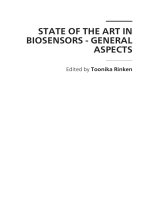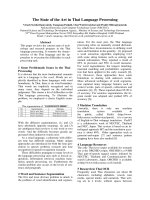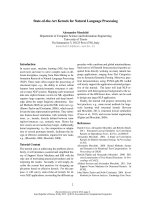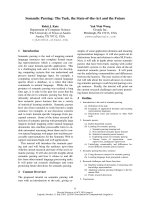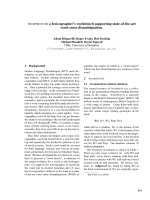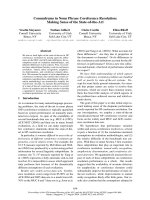state of the art in color image processing and analysis
Bạn đang xem bản rút gọn của tài liệu. Xem và tải ngay bản đầy đủ của tài liệu tại đây (4.58 MB, 50 trang )
Lecturer:
Assoc. prof. Mihaela GORDAN
Technical University of Cluj-Napoca,
Faculty of Electronics, Telecommunications and
Information Technology,
Communications Department
e-mail:
Office tel.: +40-264-401309
Office address: CTMED Lab., C. Daicoviciu 15,
Cluj-Napoca, ROMANIA
State of the art in color image
processing and analysis
SSIP’08 – Vienna, Austria
Color image processing & analysis
Presentation contents
1.
2.
3.
4.
Human perception of color images
Color imaging applications – overview
Color spaces, properties, metrics
Basic color image processing:
4.1. Color image quantization
4.2. Color image filtering
4.3. Color image enhancement
5. Color image segmentation
6. Color image analysis
6.1. Color features
6.2. Color based object tracking
6.3. Some analysis examples
6.4. Some open issues: color saliency; color constancy
SSIP’08 – Vienna, Austria
Color image processing & analysis
1. Human perception of color images (1)
•
Perception of color – crucial for many machine vision applications
•
General observation:
•
•
•
most color image processing algorithms consider one pixel at a time,
but in the HVS – the color perceived at a spatial location is influenced by
the color of all the spatial locations in the field of view!
Future issues for color image processing: use the human visual
models to describe the color appearance of spatial information, to
replace the common low level (pixel-level) approaches => future
trends: develop color image processing and analysis algorithms
based on high level concepts
SSIP’08 – Vienna, Austria
Color image processing & analysis
1. Human perception of color images (2)
•
The human color vision system:
Primary light
source
Human eye
Photoreceptors:
Rodes and cones
Reflected light
Object’s reflectance
SSIP’08 – Vienna, Austria
Color image processing & analysis
1. Human perception of color images (3)
•
Photoreceptors in retina:
•
•
•
Rods = sensitive to low levels of light; can’t perceive color
= absent in the fovea; maximum density in 180 eccentricity annulus
=> “peripheral vision field”
Cones = sensitive to normal light level (daylight); perceive color
= 3 types of cones: long (L), medium (M), short (S) wavelength
= maximum density in fovea (“central visual field”, 20 eccentricity)
Types of vision (visual response):
•
•
•
Scotopic vision
= monochromatic vision
= rods only active below 0.01 cd/m2
Photopic vision
= color vision
= cones only active above 10 cd/m2
Mesopic vision => rods and cones active
SSIP’08 – Vienna, Austria
Color image processing & analysis
1. Human perception of color images (4)
•
Human color visual models – basic visual process:
Luminance;
Opponent
chrominance
channels
•
Basic processing;
Feature extraction;
Cognitive functions
Optic nerve
Spatial and temporal perception:
•
Visual info – simultaneously processed in several “visual channels”:
- high frequency active channels (P-channels): perception of details
- medium frequency active channels: shape recognition
- low frequency active channels (M-channels): perception of motion
=> The simultaneous results of the 3 channels, achromatic & chromatic,
- filtered by specific spatial and temporal contrast sensitivity
functions (CSFs); achromatic CSF > chromatic CSF
- combined further in the vision process
SSIP’08 – Vienna, Austria
Color image processing & analysis
1. Human perception of color images (5)
•
Human color visual model – a point of view:
•
•
Still an open research issue; gap between traditional computer vision and
human vision sciences => new human vision models needed
The mixed image-based and learning-based model approach:
Preattentive stage:
Extract low-level data
for object recognition:
Shape, color & texture
Interpretation stage:
Extract high-level data
for object recognition:
Semantic information
There’s a bag of
fresh lemons in
the lower middle
part of the image
SSIP’08 – Vienna, Austria
Color image processing & analysis
2. Color imaging applications - overview
I.
Consumer imaging applications:
•
•
•
Mostly involves image processing, image enhancement
Color management challenges => achieve WYSIWYG concept, by
color appearance models & color management methods – standardized
Basic applications fields: graphics arts; HDTV; web; cinema; archiving,
involving image/video restoration, colorization, image inpainting
II. Medical imaging applications:
•
•
•
Mostly involves image analysis
Challenges => model image formation process & correlate image
interpretation with physics based models;
=> analyze changes over time
Methods: use low level features & add high level interpretation to assist
diagnostic
III. Machine vision applications:
•
Robot vision; industrial inspection => image analysis & interpretation
methods – similar to medical imaging
SSIP’08 – Vienna, Austria
Color image processing & analysis
3. Color spaces, properties, metrics (1)
•
Color spaces properties:
•
P1. Completeness:
Def.1: A color space SC is called visually complete iff includes all the colors
perceived as distinct by the eye
Def.2: A color space SC is called mathematically complete iff includes all the
colors possible to appear in the visible spectrum
•
P2. Compactness:
Def.: A color space SC is called compact if any two points of the space si, sj are
perceived as distinct colors
•
Note: One can obtain a compact color space from a mathematically complete color
space through color space quantization (e.g.: vector quantization)
SSIP’08 – Vienna, Austria
Color image processing & analysis
3. Color spaces, properties, metrics (2)
•
P3. Uniformity:
Def.1: A color space SC is called uniform if a distance norm dC over SC can be
defined so that: dC(si, sj) ~ perceptual similarity of si and sj
•
Note: Usually, dC = Euclidian distance
•
P4. Naturalness:
Def.: The color space SC is called natural if its coordinates are directly correlated
to the perceptual attributes of color.
The perceptual attributes of color = the HVS specific attributes in the perception
and description of a color: Brightness; Nuance (Hue); Saturation (Purity).
•
Note: the RGB space (the primary color space) only satisfies completeness =>
the need to define other spaces for color representation.
SSIP’08 – Vienna, Austria
Color image processing & analysis
3. Color spaces, properties, metrics (3)
•
Conventional color spaces:
•
•
•
Reversible transforms of the primary (RGB) color space
Classified as linear and non-linear
Linear transforms to obtain color spaces = rotations and scalings of the
RGB cube (OPP, YUV, YIQ, YCbCr, XYZ, Ohta I1I2I3 …)
s( C ) = T( C )s , ∀ s ∈ S( R ,G ,B ) .
( OPP )
T
1 1⎤
⎡ 1
⎢− 1 − 1 2⎥ ;
=⎢
⎥
⎢ 1 − 2 1⎥
⎣
⎦
( YCrCb )
T
( YUV )
T
0.587 0.114⎤
⎡ 0.299
⎢− 0.147 − 0.289 0.436⎥ ;
=⎢
⎥
⎢ 0.615 − 0.515 − 0.1 ⎥
⎣
⎦
0.587
0.114 ⎤
⎡ 0.299
⎢ 0.5
=⎢
− 0.4187 − 0.0813⎥ .
⎥
⎢− 0.1687 − 0.3313
0.5 ⎥
⎣
⎦
( I1 I 2 I 3 )
T
( XYZ )
T
0.2 ⎤
⎡ 0.49 0.31
⎢0.177 0.812 0.011⎥ .
=⎢
⎥
⎢ 0
0.01 0.99 ⎥
⎦
⎣
⎡ 1/ 3 1/ 3 1/ 3 ⎤
= ⎢ 1/ 2
0 − 1 / 2⎥ .
⎥
⎢
⎢− 1 / 4 1 / 2 − 1 / 4⎥
⎦
⎣
(
s = T( C )
)−1s( C ) ,
∀ s( C ) ∈ S ( C ) .
SSIP’08 – Vienna, Austria
Color image processing & analysis
3. Color spaces, properties, metrics (4)
•
Conventional color spaces (2):
•
Non-linear transforms to obtain color spaces => needed to match the
perceptual color attributes by their coordinates (CIE L*a*b*, CIE L*u*v*,
HSV, HLS, HSI, Munsell…)
SSIP’08 – Vienna, Austria
Color image processing & analysis
3. Color spaces, properties, metrics (5)
•
Denote: r, g, b – color primaries normalized to [0;1]
=> HSV space transformations:
Reverse transform:
SSIP’08 – Vienna, Austria
Color image processing & analysis
3. Color spaces, properties, metrics (6)
•
Ad-hoc color spaces:
•
•
Ideea: define the color space according to the most characteristic color
components of a set of images
application-dependent
=> e.g. YST color space for human faces: Y – luminance; S – color
average value from the set of faces; T – the orthogonal to Y and S
Some basic approaches:
(1) For image segmentation:
Fischer distance strategy to segment object-background (LDA
generated color space)
(2) For feature detection:
Diversification principle strategy for selection & fusion of color
components => automatically weight color components to
balance between color invariance & discriminative power
(3) For object tracking:
Adaptive color space switching strategy => dinamically select
the best color space for given environment lighting (from all
conventional color spaces)
SSIP’08 – Vienna, Austria
Color image processing & analysis
3. Color spaces, properties, metrics (7)
•
Color difference metrics in color spaces:
•
•
•
In linear transformed-based color spaces => Euclidian metric –
common choice
In non-linear transformed based spaces => metrics should take into
account what is linear and what is angular! (i.e. see hue! – an angle)
Some basic metrics:
(1) Variants of Euclidian distance for linear spaces:
Minkowski distance (q=1 – city-block; q=2 – Euclidian):
Mahalanobis distance:
SSIP’08 – Vienna, Austria
Color image processing & analysis
3. Color spaces, properties, metrics (8)
•
Color difference metrics in color spaces – contnd.:
(2) CIEDE2000:
defined for CIELAB space:
SSIP’08 – Vienna, Austria
Color image processing & analysis
3. Color spaces, properties, metrics (9)
SSIP’08 – Vienna, Austria
Color image processing & analysis
4. Basic color image processing
•
Important note: Color image processing is not merely the
processing of 3 monochrome channels!!!
•
Yet => some generalizations and applications of monochrome
(grey-level) image processing can be derived/used in color image
processing and analysis:
•
Generalization of scalar algorithms to the vectors case (color space)
•
Processing of the luminance (brightness) component alone
•
Independent & different processing of each coordinate, after the color
space transform (linear or non-linear transform)
SSIP’08 – Vienna, Austria
Color image processing & analysis
4.1. Color image quantization (1)
•
Goal of quantization: build a reduced color space, with the smallest possible
number of colors (the representative image colors), so that the perceived difference
between the quantized image and original image → 0.
•
Open problem: definition of “perceived difference”;
•
•
•
1st approach: minimize the sum of distances between colors and the
centers of color clusters resulting in the quantization process ( minimize
the sum of distances within each cluster)
2nd approach: maximize the sum of distances between the colors in
different clusters ( maximize the sum of distances between cluster pairs)
Typical approach for color space quantization: VQ
SSIP’08 – Vienna, Austria
Color image processing & analysis
4.1. Color image quantization (2)
•
Vectorial Quantization (VQ) of the color space:
•
•
Several versions; all based on LBG original algorithm
Motivation: reduce (usually drastically!) the number of colors in a group
of images. How? Cluster similar colors together (color points = vectors
=> the name “vector quantization” = VQ); determine the cluster centers;
replace each image color with the closest cluster center
G
VQ codebook
(Voronoi diagram)
B=0 for all pixels
R
SSIP’08 – Vienna, Austria
Color image processing & analysis
4.1. Color image quantization (3)
•
Vectorial Quantization (VQ) of the color space – basic algorithm:
•
•
Let: N – # of colors in the (set of) image (s); M – target number of colors
(M<
1. Initialization: choose M “codewords”, { sq1, sq2,..., sqM} lying in the
color space chosen for quantization
codeword initialization
2. Codebook optimization:
2.1. For each i=1,2,...,M, assign si to the cluster k that satisfies:
k = arg min d (s i , s qj )
j =1, 2 ,..., M
=> The initial partition regions = the initial clusters B1, B2,...,BM.
2.2. Compute the overall distortion:
1 M
D = ∑ ∑ d (s i , s qj )
N j =1 s ∈B
1
2.3. If D>ε => update codewords: s qj =
∑ si
card (B j ) s ∈B
i
j
i
j
and go to step 2. Otherwise => convergence reached => final
codebook and codewords.
SSIP’08 – Vienna, Austria
Color image processing & analysis
4.2. Color image filtering (1)
•
Most popular filtering goal : remove noise (color noise) from the original
•
Why is noise disturbing?
Perceptually: image appearing visually unpleasant,...
For analysis applications: noise = high frequency => same as sharp edges...
•
Noise filtering algorithms for color images:
Most common types of noise: impulse noise; Gaussian noise; speckle noise;
stripping noise
Several types of vector filtering operators derived in last 10 years
Important class of noise filtering operators for color images: rank vector filters
Open issues: develop adaptive filters for color images, to preserve fine details &
reduce all types of noise efficiently (including additive!)
filters capable to
adapt to local image statistics!
Other filtering approaches: morphological operators; wavelets; PDEs...
SSIP’08 – Vienna, Austria
Color image processing & analysis
4.2. Color image filtering (2)
•
Vector median filters for color images:
•
•
•
Particular case of rank filters
Principle: for each pixel location (i, j):
- take the brightness/color values in a window W(i, j)
- order the brightness/color values in increasing order
- output: new brightness/color at (i, j) = middle of string
Very useful for impulse color noise:
Original (noise-free)
30% impulse noise
Original (noise-free)
10% impulse noise
SSIP’08 – Vienna, Austria
Color image processing & analysis
4.2. Color image filtering (3)
•
Vector median filters for color images – some practical algorithms:
Note:
o
Biggest problem in vector median filtering generalization for color images:
(1) how to define the ordering?; (2) what means “increasing color values”?
o
“Brute approach” (i.e. in RGB space => treat each channel independently, apply 3
median filters independently) does not work! (color distortion):
3 1 window, s1=[7 117 182], s2=[250 250 80], s3=[25 10 75]=> filter
independently: s=[25 117 80]...
=> solutions:
1. The Adaptive Scalar Median Filter:
•
•
•
•
Consider 2 representations of the image: in RGB and HSI color space =>
denote: sp=[R G B]T; sh=[h s i]T
W – any window around the current pixel (x,y); e.g. W(x,y)[3 3].
Let: rm, gm, bm – average R, G, B values inside W(x,y);
Compute: [hm sm im]T =HSI([rm gm bm]T);
SSIP’08 – Vienna, Austria
Color image processing & analysis
4.2. Color image filtering (4)
•
Additional : (xR,yR) = pixel position in W(x,y) that satisfies:
R(xR,yR)=median{R(x,y)|(x,y) in W(x,y)}
(xG,yG) = pixel position in W(x,y) that satisfies:
G(xG,yG)=median{G(x,y)|(x,y) in W(x,y)}
(xB,yB) = pixel position in W(x,y) that satisfies:
B(xB,yB)=median{B(x,y)|(x,y) in W(x,y)}
⇒ We can now build a “median matrix” M[3×3]:
⎡ R( xR , y R ) R ( xG , yG ) R ( xB , y B ) ⎤
M = ⎢G ( xR , y R ) G ( xG , yG ) G ( xB , y B )⎥
⎢
⎥
⎢ B( xR , y R ) B ( xG , yG ) B ( xB , y B ) ⎥
⎣
⎦
•
Note:
o
o
o
The diagonal of M – most likely to be the median color, but is a new color!!!
Any column of M = an existing color , but not necessarily really the median!
=> Virtually one can select as filter’s output any combination of RGB values
=> how do we know which one is optimal?


